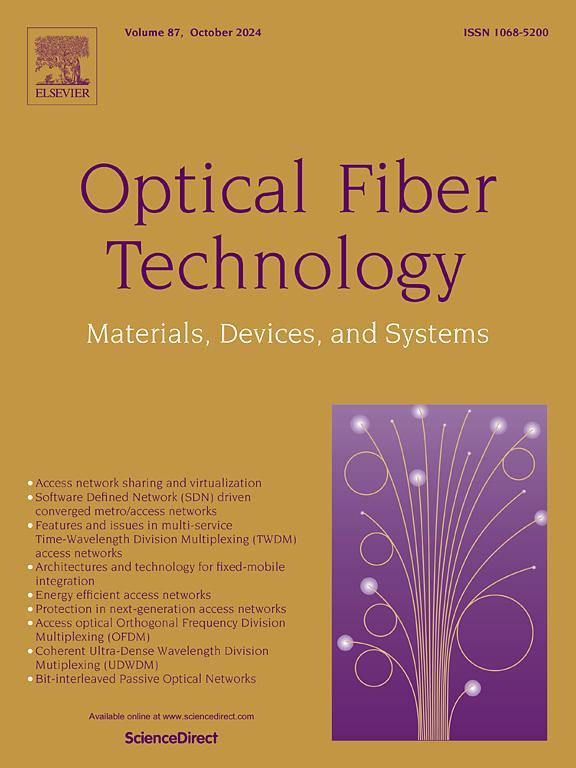Study on thermal effect and optical attenuation characteristics of SiO2-GeO2 single-mode fiber for silicon photonic modulator
IF 2.7
3区 计算机科学
Q2 ENGINEERING, ELECTRICAL & ELECTRONIC
引用次数: 0
Abstract
Optical fibers are critical components of silicon photonic modulators. To investigate the effects of copper wire Joule heating and electro-optical energy conversion loss on optical fibers, communication single-mode fiber (C-SMF) and waveguide single-mode fiber (W-SMF) were selected for the experiments in this study. The core diameter of the C-SMF was 9 μm, whereas that of the W-SMF was 8.2 μm; both fibers had an overall diameter of 125 μm. Both fiber cores were composed of 96 wt% SiO2 and 4 wt% GeO2, while their claddings are made of 100 wt% SiO2. In this study, a transmission electron microscope (TEM) was used to perform elemental analysis of the cores, and the mechanical properties and crystallinity of the fibers were compared. Various heating effects were simulated through heat treatment, thermal cycling, and point-heating tests to investigate the changes in the properties of the fibers. In addition, a self-designed polymer-based photonic integrated circuit (PIC) chip was used to analyze the core morphology and observe the light profile.
The results indicate that C-SMF exhibits lower tensile strength but higher elongation, whereas the center of W-SMF contains SiO structures that absorb optical signals and reduce transmission efficiency under high-temperature conditions. Owing to the rapid cooling after the thermal treatment, the fibers could not form stable structures, leading to reductions in both the crystallinity and tensile properties. The crystallinity decreased owing to the impact of thermal stress on the structure after 100 cycles of the thermal cycling test (TCT). After TCT 700 cycles, the slow diffusion of Ge and the localized Ge-rich area promoted grain growth in the W-SMF. Regarding optical attenuation, the W-SMF showed improved performance after thermal treatment owing to defect reduction through the annealing effect. However, prolonged high-temperature exposure leads to significant Ge diffusion, increased defect density, and refractive index fluctuations, ultimately leading to optical attenuation degradation. In addition to the annealing effect observed after three-point heating, the refractive index difference between the core and cladding increased, resulting in a more stable optical signal. The PIC light profile confirmed that the optical signal was transmitted not only through the core but also through the cladding, and the signal was transmitted in the fundamental mode. This study confirms the high-temperature applicability of optical fibers in silicon photonic modulators and the compatibility of optical fibers and PICs.
硅光子调制器用SiO2-GeO2单模光纤热效应和光衰减特性研究
光纤是硅光子调制器的关键部件。为了研究铜线焦耳加热和电光能量转换损耗对光纤的影响,本研究选择通信单模光纤(C-SMF)和波导单模光纤(W-SMF)进行实验。C-SMF的芯径为9 μm, W-SMF的芯径为8.2 μm;两根纤维的总直径均为125 μm。两种纤维芯由96 wt% SiO2和4 wt% GeO2组成,而它们的包层由100 wt% SiO2组成。本研究采用透射电子显微镜(TEM)对纤维芯进行了元素分析,并对纤维的力学性能和结晶度进行了比较。通过热处理、热循环和点加热试验模拟不同的加热效应,研究纤维性能的变化。此外,利用自行设计的聚合物光子集成电路(PIC)芯片对核心形貌进行了分析,并观察了光廓。结果表明,C-SMF具有较低的抗拉强度和较高的延伸率,而W-SMF中心含有吸收光信号的SiO结构,在高温条件下降低了传输效率。由于热处理后的快速冷却,纤维不能形成稳定的结构,导致结晶度和拉伸性能下降。热循环试验(TCT) 100次后,由于热应力对结构的影响,结晶度下降。tct700循环后,Ge的缓慢扩散和局部富Ge区促进了W-SMF中晶粒的生长。在光衰减方面,热处理后的W-SMF由于退火效应减少了缺陷,性能得到改善。然而,长时间高温暴露会导致Ge扩散显著,缺陷密度增加,折射率波动,最终导致光学衰减退化。除了三点加热后观察到的退火效应外,芯层和包层之间的折射率差增加,导致光信号更稳定。PIC光廓线证实了光信号不仅可以通过芯层传输,还可以通过包层传输,并且信号以基模传输。本研究证实了光纤在硅光子调制器中的高温适用性,以及光纤与光子集成电路的兼容性。
本文章由计算机程序翻译,如有差异,请以英文原文为准。
求助全文
约1分钟内获得全文
求助全文
来源期刊

Optical Fiber Technology
工程技术-电信学
CiteScore
4.80
自引率
11.10%
发文量
327
审稿时长
63 days
期刊介绍:
Innovations in optical fiber technology are revolutionizing world communications. Newly developed fiber amplifiers allow for direct transmission of high-speed signals over transcontinental distances without the need for electronic regeneration. Optical fibers find new applications in data processing. The impact of fiber materials, devices, and systems on communications in the coming decades will create an abundance of primary literature and the need for up-to-date reviews.
Optical Fiber Technology: Materials, Devices, and Systems is a new cutting-edge journal designed to fill a need in this rapidly evolving field for speedy publication of regular length papers. Both theoretical and experimental papers on fiber materials, devices, and system performance evaluation and measurements are eligible, with emphasis on practical applications.
 求助内容:
求助内容: 应助结果提醒方式:
应助结果提醒方式:


